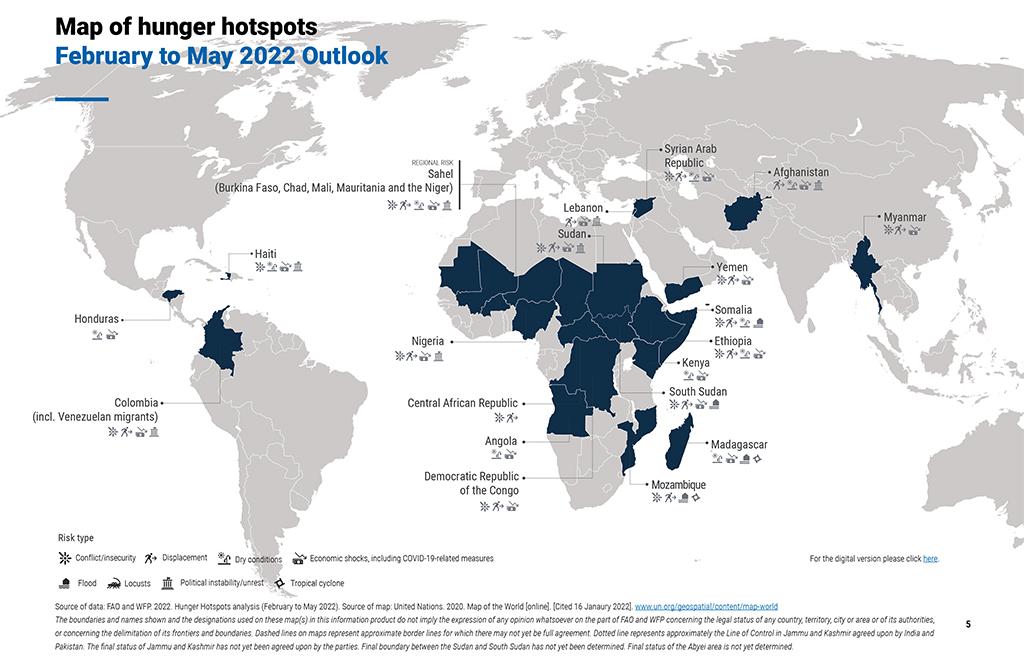UPSC Articles
(Down to Earth – News)
Feb 11: Thousands may face starvation from February to May in ‘hunger hotspots‘- https://www.downtoearth.org.in/news/africa/thousands-may-face-starvation-from-february-to-may-in-hunger-hotspots-un-agencies-81527
TOPIC:
- GS-3: International Relations
Thousands may face starvation from February to May in ‘hunger hotspots’
Context: People living in parts of 20 countries will face acute food insecurity from February through May 2022, warned Food and Agriculture Organization (FAO) and World Food Programme (WFP). Urgent and targeted humanitarian action is needed in these places to avoid putting the lives and livelihoods of this population at risk.
- Ethiopia, Nigeria, South Sudan and Yemen are on the highest alert, according to the research paper Hunger Hotspots.
- A share of the population in these four countries were projected to experience starvation and death in the last assessment by the agencies for August to November 2021.

Source: DTE
Famine
IPC defined famine as an extreme deprivation of food. This refers to a condition in which
- an area has at least 20 per cent households facing extreme lack of food
- at least 30 per cent children suffering from acute malnutrition and
- Two of every 10,000 people dying each day due to outright starvation or to the interaction of malnutrition and disease.
Area-wise
- At least 13,550 people in conflict-affected northern Nigeria and in particular Borno state could face catastrophic food insecurity (IPC Phase 5) from June to August 2022 if adequate humanitarian and resilience-building assistance are not provided.
- In Afghanistan, a total of 8.7 million people by March 2022 is expected to slide into critical levels of acute food insecurity (IPC Phase 4). This is more than double the number from the same time last year.
Drivers of food insecurity
A combination of factors are behind the acute food insecurity in these hotspots during the outlook period such as
- Organized violence and conflict: In Myanmar, Central African Republic, the Democratic Republic of the Congo, Central Sahel, Sudan, South Sudan, Somalia, the northern parts of Ethiopia, Nigeria and Mozambique, people were forced to abandon their land, homes and jobs due to conflict situations
- Economic shocks including impacts of COVID-19 pandemic will continue to drive food prices higher
- Extreme weather events:
- Weather extremes such as heavy rains, tropical storms, hurricanes, flooding, drought and climate variability
- The ongoing La Niña conditions led to an elevated risk of a two-year sequence of dry conditions, particularly in East Africa and Central Asia
- Impact of climate extremes on food security was seen in Haiti, Eastern Africa, Madagascar, Mozambique and in Afghanistan’s western region of Badghism
- Animal and plant pests and diseases
- Poor humanitarian access: Humanitarian access is limited in various ways, including administrative/bureaucratic impediments, movement restrictions, security constraints and physical constraints related to the environment.
What is happening in India?
How did India’s food system work during Pandemic?
- During the COVID-19-precipitated lockdown, the FAO, IFAD and the WFP worked in close coordination to support the Government of India’s Empowered Group 5 on facilitating supply chain and logistics management, so necessary items such as food and medicines were available.
- Over the past few decades, India has gone from being a net importer to a net exporter of food grains. This strength has been evident through the pandemic.
- During April to June 2020, Central and State governments were able to distribute around 23 million tonnes from India’s large domestic food grain reserves through Public Distribution System
- The government also successfully mobilised food rations for 820 million people from April to November 2020, including finding alternate solutions to provide food rations to 90 million schoolchildren.
- During pandemic’s initial days of lockdown, there were efforts to remove bottlenecks in the food supply chain to ensure that agricultural activities weren’t disrupted.
- As a result, agriculture grew at 3.4% during the first quarter this financial year and the area cultivated this kharif exceeded 110 million hectares.
Challenges Ahead for India
- High number of Malnourished: The Comprehensive National Nutrition Survey 2016-18 revealed that over 40 million children are chronically malnourished, and more than half of Indian women aged 15-49 years are anaemic.
- Climate change continues to be a real and potent threat to agrobiodiversity, which will impact everything from productivity to livelihoods across food and farm systems.
- Small Land Size: Intensified food production systems with excessive use of chemicals and unsustainable farming practices cause soil degradation, fast depletion of groundwater table and rapid loss of agro-biodiversity. These challenges multiply with an increase in fragmentation of landholdings.
Way Ahead & Learnings for India
- The way we produce food must change through agroecology and sustainable production practices in agriculture and allied sectors
- India must stop the waste — one-third of the food we produce is wasted.
- COVID-19 and now the new realityis an opportunity to adopt innovative solutions based on scientific evidence so they can build back better and make food systems more resilient and sustainable
- Everybody — governments, the private sector, civil society and local communities- has a role to play in transforming our food systems so they can withstand increasing volatility and climate shocks
Can you answer the following questions?
- Discuss the concept of food security. Also examine the reasons for the world food problem.
- What are the factors contributing to India’s below par performance on addressing hunger and malnutrition despite having adequate food stocks? Examine.
- There are many international organisations and programmes that work for the eradication of extreme poverty and hunger. Can you discuss at least three of them? Also, discuss their mandate and objectives.













